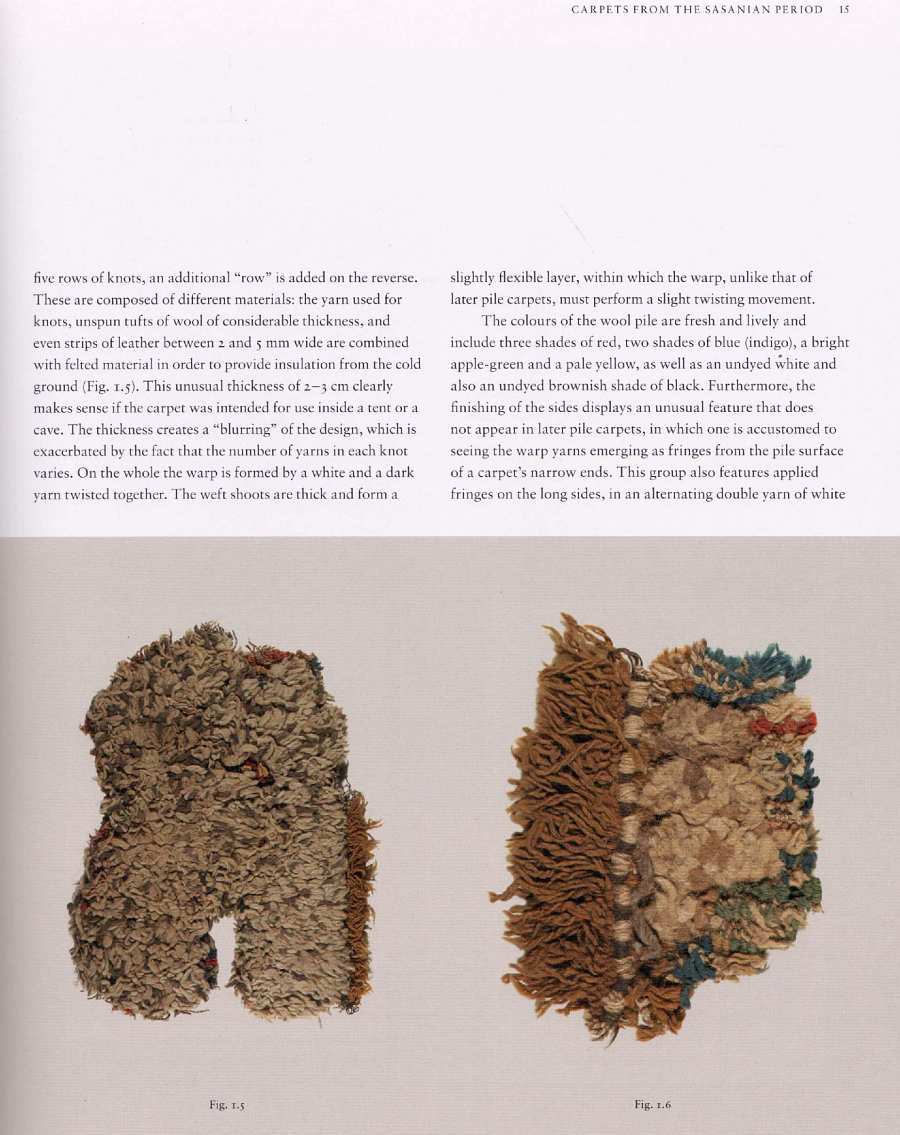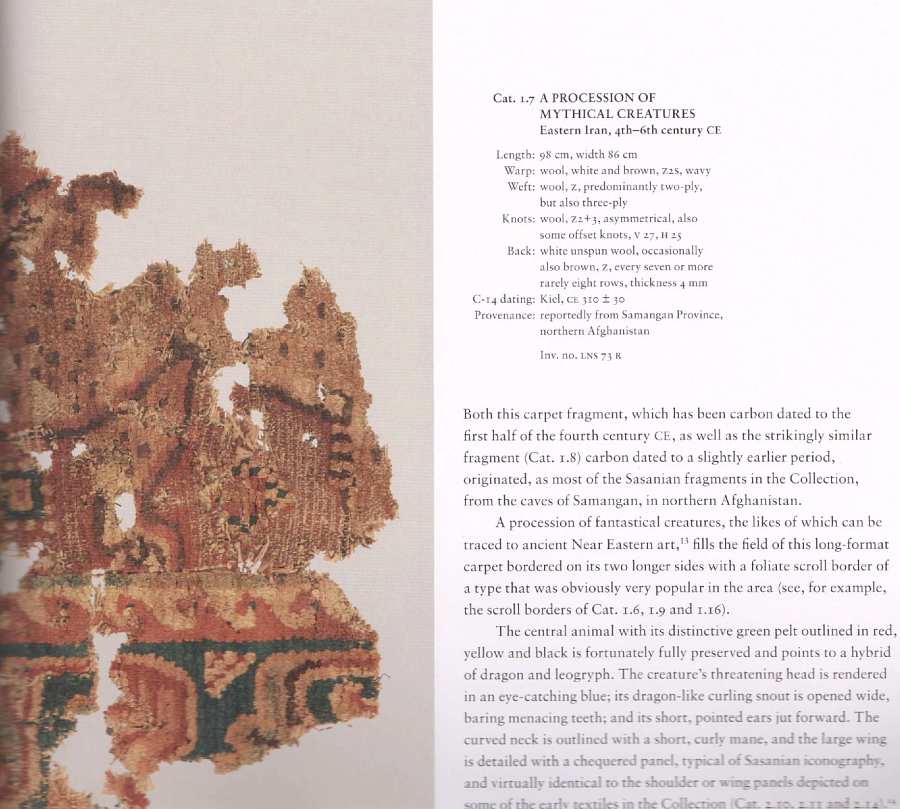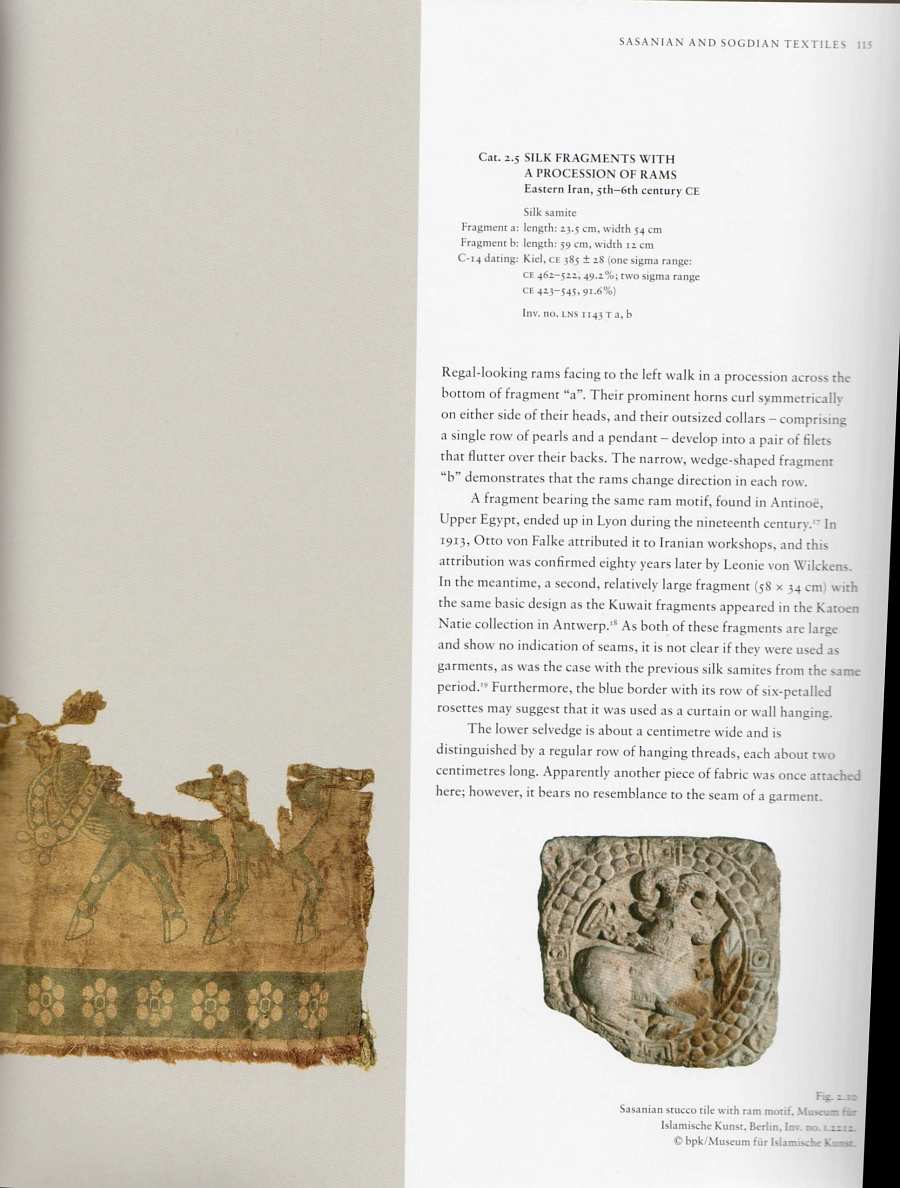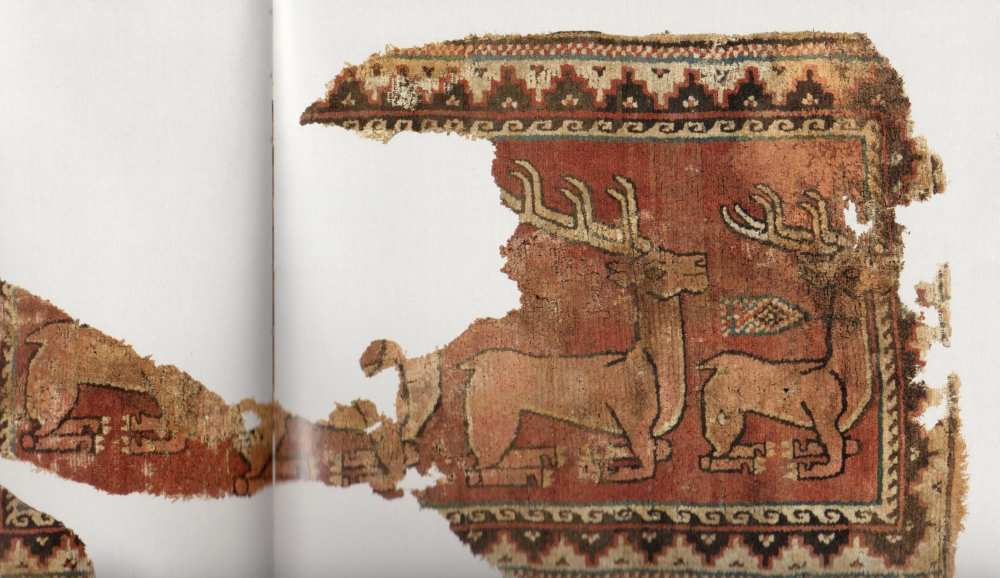Sogdian
Hi Horst and all,
Quote:
I
don’t think it needs a full discussion of the Pazyryk finds at this stage
to understand, that, with regard to the rug design we are
discussing (Sogdian ‘picnic rug’, Egyptian bull’s shabrack, Kurgan V
shabrack), the Sogdians and the Skyths at their time have independently
drawn from the same source in the Wider Upper Mesopotamia, and that the
Sogdians very probably were not the principal influence to the development
of rug designs in Turkestan.
Why Horst! You know, I
do indeed agree with you, I do! The people who in this thread are still
discussing alternative sources of inspiration, other than Mesopotamia at
large, for the design of Turkmen rugs, (and this even after you have been
teaching them the truth) are obviously wasting their time and, worse
still, yours. Especially since you did indeed overflow us with
illuminating examples of antique (18th BCE to 18th AD!) Wider Upper
Mesopotamian rugs and with striking comparisons with traditional Turkmen
design.
It is therefore conscious of my innate lack of
understanding and with the nagging suspicion that I am perhaps
doing something stupid, that I’ll propose below some more reasons (other
than design and motifs, a topic better ascribed to Martin’s sins), for an
hypothetical Sogdian influence on Turkmen rug
design.
_______________
My note will concentrate on where the
Sogdians lived, what they did best for a living and what happened to them
after their names ceased to make the headlines in the News
(1).
FIG A: Sogdian Satrapy in Achaemenid Empire ca. 500
BCE: 
FIG
B: Sogdiana in ca 640 AD
The
Sogdian traditionally settled part of the Transoxiana region, northeast of
the middle Amu-darya (does rings a Turkmen bell ), around cities which
became later known as Samarkand and Bukhara. There was already a Sogdian
Satrapy during the heydays of the Achaemenid Empire (5th century BCE),
with a local army quite able to teach a lesson to any unruly Scythian
neighbor (the famous “Pointed-Hat-Scythians” discussed in another thread
).
Alexander’s soldiers had quite a few cats to skin when he toured
the region around 327 BCE. But he did the (surviving-) Sogdians a big
favor, making them understand that trading- and creating high value goods
was a much safer and more enjoyable way of life than confronting Central
Asian rogues. Henceforth they increasingly concentrated on getting rich,
leaving politics and bruises to other people (successively the
Greco-Bactrians, Great Yuezi & Kuchans, Hephtalites, Uyghurs,
Qarakhanids, Arabs, Samanid Persans, Mongols, Timurids, Uzbeks
etc…)
Much to his immediate western neighbors’ delight (The Yuezi,
Tokarians), Emperor Wuedi of the China’s Han dynasty decided in 138 BCE to
try and jump-start his country export-business and sent a certain Zhang
Qiang westward to perform a much needed market-analysis. After an eventful
13 years-long journey, spoiled by two long periods of captivity, this
soldier & diplomat returned with precious informations and a wife.
Emperor Wuedi thus decided to open a new commercial route to the west,
henceforth famous as the Silk Road.
At this stage the Sogdians were
already in their starting blocks. Progressively, they organized an
efficient, direct commercial system, with expats everywhere, between China
and the important potential markets and suppliers, starting obviously with
Persia. India was next and on-line before 400 AD, then Constantinople
around 540 AD. Their dialect became the lingua franca of the Silk Road and
“Sogdian” the generic name for any Silk Road businessman. They reaped most
benefits of the Silk Road, and not, as erroneously recently claimed :D the
Scythians, who, in 100 BCE-100 AD, had anyway already been largely
absorbed or eliminated by other nomad ethnic groups.
FIG C: Map
of the Silk road.
The
Sogdians became the dominant players in exporting Chinese silk, paper and
copper, as well as in importing into China superior Central Asian war
horses (the famous Celestial Horses), alfalfa seeds for growing horse
fodder, Baltic amber, Persian silverware, Roman wool textile, Takla-Makan
jade etc.. . They never neglected to deal as well with their own
production: As a Chinese visitor, called Xuangzang, dully reported in ca.
630 AD, they produced mainly paper (2), glassware, carved wood and
oyez,oyez Turkotekers, also carpets.
Rug
production can be inferred also from the clearly Sogdian rugs, featured in
a number of Afrasiab (Samarkand) and Pendjikent murals. FIG D, E,
F.
IMHO, the silk lampa in FIG G is quite interesting too, with its
motifs reminiscent of the minor- and major guls on Timurid (3) and Turkmen
rugs.
FIG D: Sogdian. 7th AD. Afrasiyab mural. Detail of the
Zoroastran procession. 
FIG
E: Sogdian. 7th-8th AD. Pendjikent mural. The party.
FIG
F: Sogdian. 7th-8th AD. Pendikent mural. Tigers attacking a
hunter.
FIG
G: Sogdian. 8th AD. Silk lampa with major and minor “guls”. 
After
the 10-11th century AD, the Sogdians’ role, as a main conveyor-belt for
goods, fashions, design (4) and religious ideas (5) in Central Asia,
gradually decreased. Their ethnic group became more and more “diluted”
with neighbors and new (eager- or reluctant- ) immigrants. The Sogdians
though, remained an important part of what came to be known eventually as
the Farsi-speaking “Tajiks” of Samarkand and Bokhara. People who,
typically, like the Sogdians, never really bothered to contest the
political / military power of their various successive masters, but kept
instead the leadership in religious- (by then Islamic), intellectual- and
especially in commercial matters(6).
The Sogdians were installed,
for more than 1500 years, very near to the place, (just east, north and
west of the Aral Sea), where the Oghuz Turkmen initially settled when they
arrived from the eastern steppe, between the 9th and 10th century
AD.
Thus they became their most immediate northwestern neighbors
(7).
From their new territory, many enterprising Turkmen launched
wave after wave of horsemen towards Persia and beyond, and created a
number of successive Empires starting with the Great Seldjuk Empire
(11th-12th century AD).
Their most stay-at-home brethren first moved a
bit further to the west till the eastern shore of the Caspian Sea (did
they mind the Mongol lack of manners?), before dispersing their tribes all
around the Qara-Qum desert. Most of them opting for places inside- or just
to the West of the Bukhara Khanate. (8)
TO be continued in my
next post.It appears that I have reached the legal number of
words


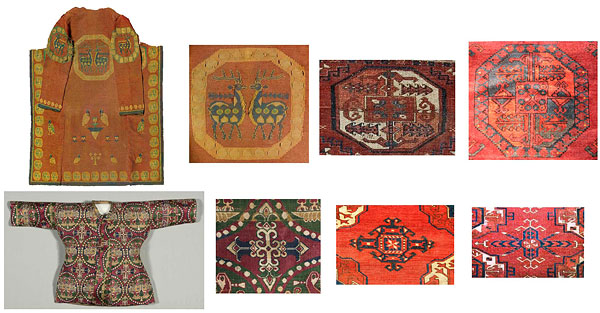

















 . Amazing how esthetically influences can survive
centuries, even millenaries and travel thousands of km!
. Amazing how esthetically influences can survive
centuries, even millenaries and travel thousands of km!

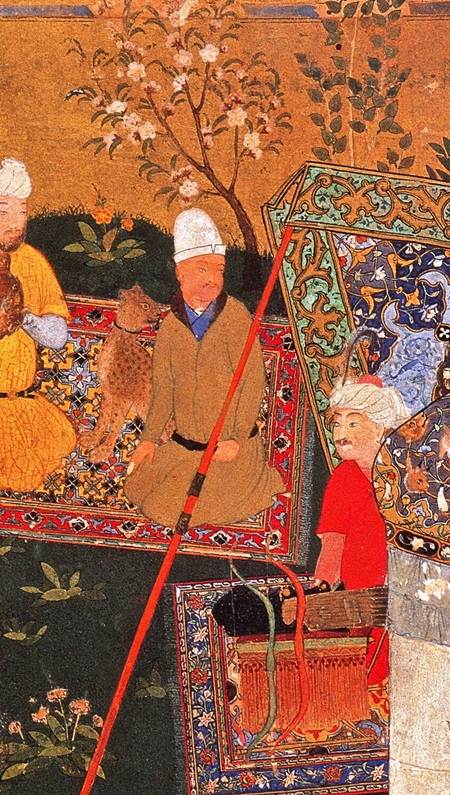


































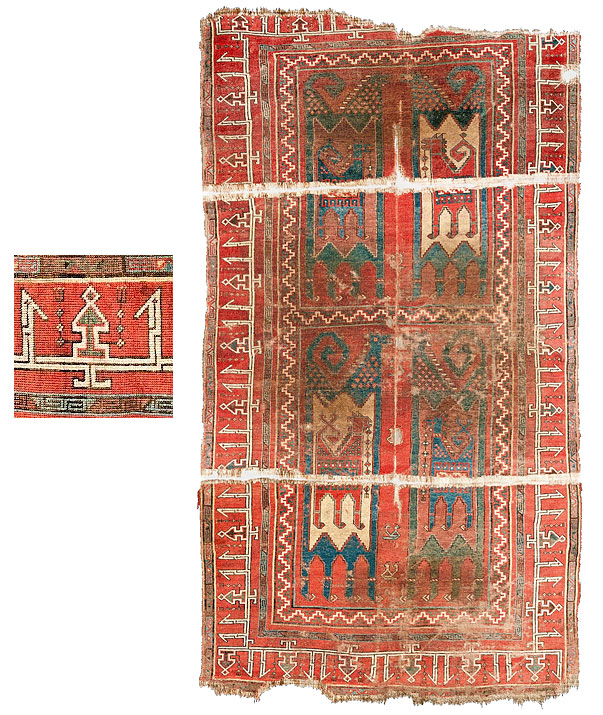







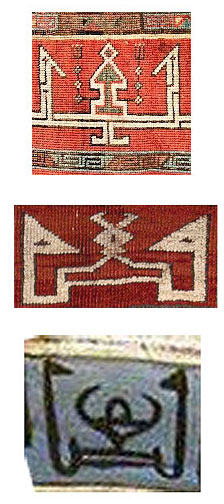



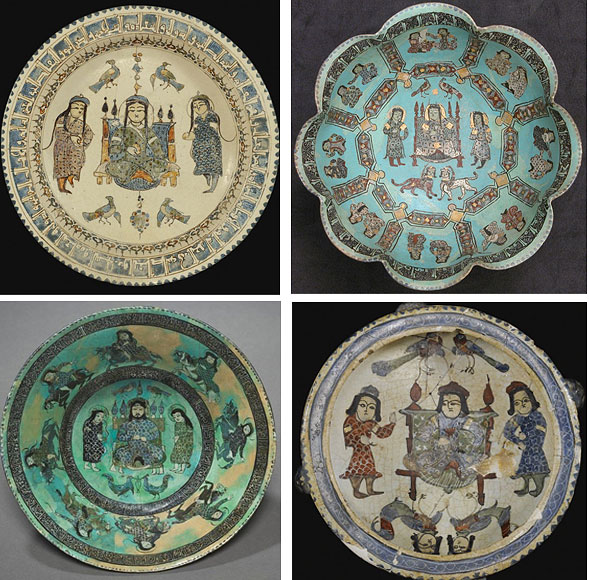








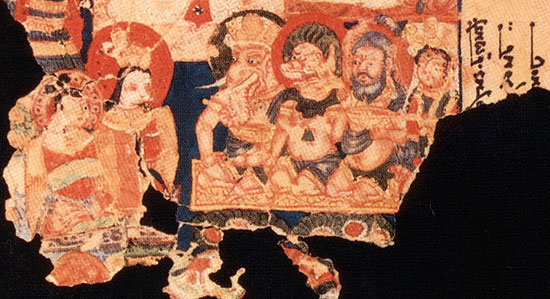
















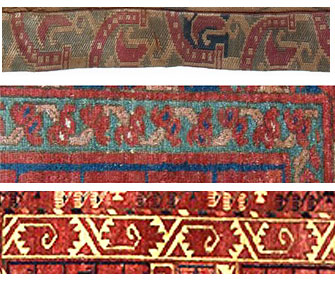







































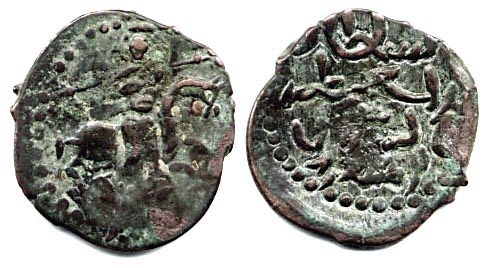
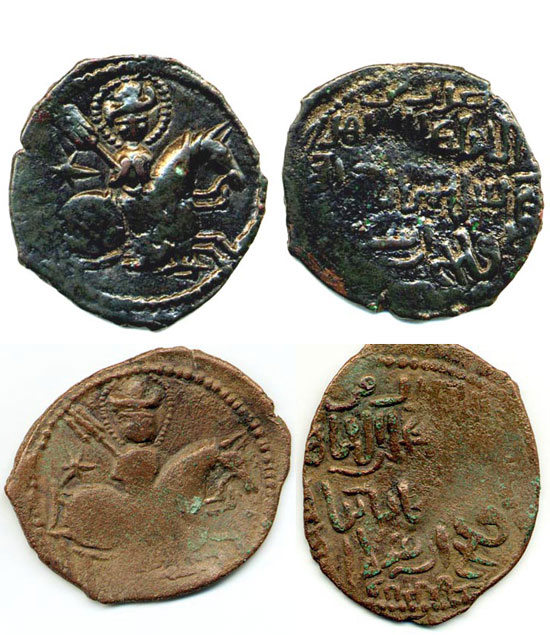

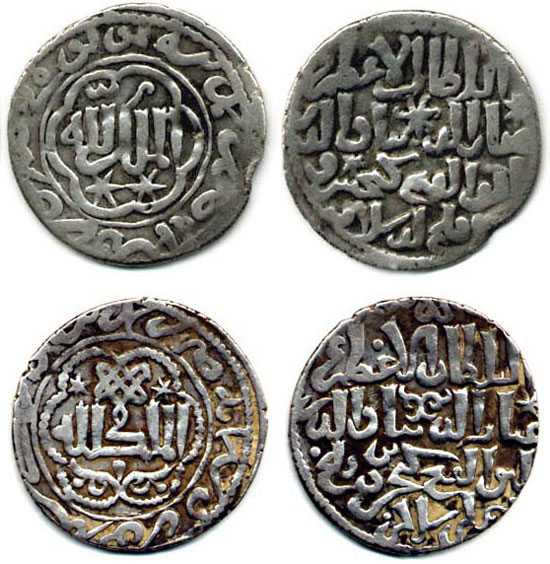


















 , in Mesopotamia, which
some are advertising as the model for Turkmen weavers?).
, in Mesopotamia, which
some are advertising as the model for Turkmen weavers?). It seems to me that Martin’s hypothesis of a
stylistic influence of the Sogdian weavers and artists on the nomad
Turkmen is very far from being harebrained, considering especially the
wealth of thought provoking artistic material which Martin provided in
this thread.
It seems to me that Martin’s hypothesis of a
stylistic influence of the Sogdian weavers and artists on the nomad
Turkmen is very far from being harebrained, considering especially the
wealth of thought provoking artistic material which Martin provided in
this thread. 








